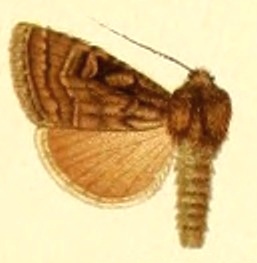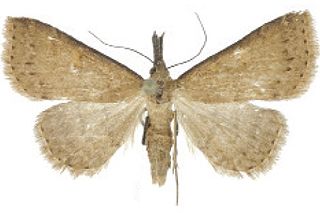
The Noctuidae, commonly known as owlet moths, cutworms or armyworms, are a family of moths. They are considered the most controversial family in the superfamily Noctuoidea because many of the clades are constantly changing, along with the other families of the Noctuoidea. It was considered the largest family in Lepidoptera for a long time, but after regrouping Lymantriinae, Catocalinae and Calpinae within the family Erebidae, the latter holds this title now. Currently, Noctuidae is the second largest family in Noctuoidea, with about 1,089 genera and 11,772 species. However, this classification is still contingent, as more changes continue to appear between Noctuidae and Erebidae.

The flame is a moth of the family Noctuidae. It is found throughout Europe then east across the Palearctic to Armenia, western Siberia and Amur, Korea and Japan. The range extends into northern India.

Xestia is a genus of noctuid moths. They are the type genus of the tribe Xestiini in subfamily Noctuinae, though some authors merge this tribe with the Noctuini. Species in this genus are commonly known as "clays", "darts" or "rustics", but such names are commonplace among Noctuidae. Xestia moths have a wide distribution, though they most prominently occur in the Holarctic.

Agrotis is a genus of moths of the family Noctuidae. The genus was erected by Ferdinand Ochsenheimer in 1816. A number of the species of this genus are extinct.

The Noctuinae are a subfamily of the family Noctuidae, and is composed of moths. The larvae of many species feed on roots or stems of various grasses. Some are generalist feeders which makes them potential pests.

The mullein moth is a noctuid moth with a Palearctic distribution. The species was first described by Carl Linnaeus in his landmark 1758 10th edition of Systema Naturae.

The Boarmiini are a large tribe of geometer moths in the Ennominae subfamily.

Acronicta rumicis, the knot grass moth, is a species of moth which is part of the genus Acronicta and family Noctuidae. It was first described by Carl Linnaeus in his 1758 10th edition of Systema Naturae. It is found in the Palearctic region. A. rumicis lives and feeds on plants located in wide-open areas. At its larval stage, as a caterpillar, it causes such a large impact as a crop pest that it has received much attention and research. A. rumicis feeds on maize, strawberries and other herbaceous plants.

Eugraphe is a genus of noctuid moths. They belong to the tribe Xestiini of the typical noctuid subfamily Noctuinae, though some do not separate this tribe and include the genus in the Noctuini. It is closely related to Anagnorisma, Coenophila and Eugnorisma, and as it seems most closely to the first of these. The geographic range is Palearctic, north of the Alpides but including the Caucasus, and between the Arctic and the arid lands of Central Asia.

Goniographa marcida is a moth of the family Noctuidae. It is found endemic to the Kopet-Dagh mountain system in Turkmenistan and Iran.
Goniographa decussa is a moth of the family Noctuidae. It is found in the western Tien-Shan Mountains.
Goniographa discussa is a moth of the family Noctuidae. It is found from the Zeravshan Mountains and Hissar Mountains through the western Pamirs to north-eastern Afghanistan (Badakhshan).
Goniographa shchetkini is a moth of the family Noctuidae. It is only known from a single location near the Liangar Glacier.

Goniographa funkei is a moth of the family Noctuidae. It is found in the western Tien-Shan Mountains, the Hissar Mountains and the western parts of the Pamir massif.
Goniographa metafunkei is a moth of the family Noctuidae. It has a strictly limited distribution in the western part of the Tien-Shan Mountains and the Alai Mountains.
Goniographa naumanni is a moth of the family Noctuidae. It is confined to the Hissar Mountains, the western Pamirs and the north-eastern territories of Afghanistan.
Xestia ornata is a moth of the family Noctuidae. It is found from the northern Tien-Shan Mountains through the Pamirs and Hissar-Darwaz system to eastern Afghanistan (Nuristan).

Naarda ardeola is a species of moth of the family Noctuidae. It was first described by Balázs Tóth and László Aladár Ronkay in 2014. It is found in the mountains of northern Thailand.

Naarda egrettoides is a species of moth of the family Noctuidae. It was first described by Balázs Tóth and László Aladár Ronkay in 2014. It is found in the mountains of northern Thailand.

Neopalpa donaldtrumpi is a moth species of the genus Neopalpa occurring in Southern California and Northern Mexico. It was described in 2017 by Iranian-Canadian scientist Vazrick Nazari. Known for its yellowish-white head scales being reminiscent of Donald Trump's hair, the moth was given its name because Nazari stated that he wanted "to bring wider public attention to the need to continue protecting fragile habitats in the US that still contain many undescribed species."














